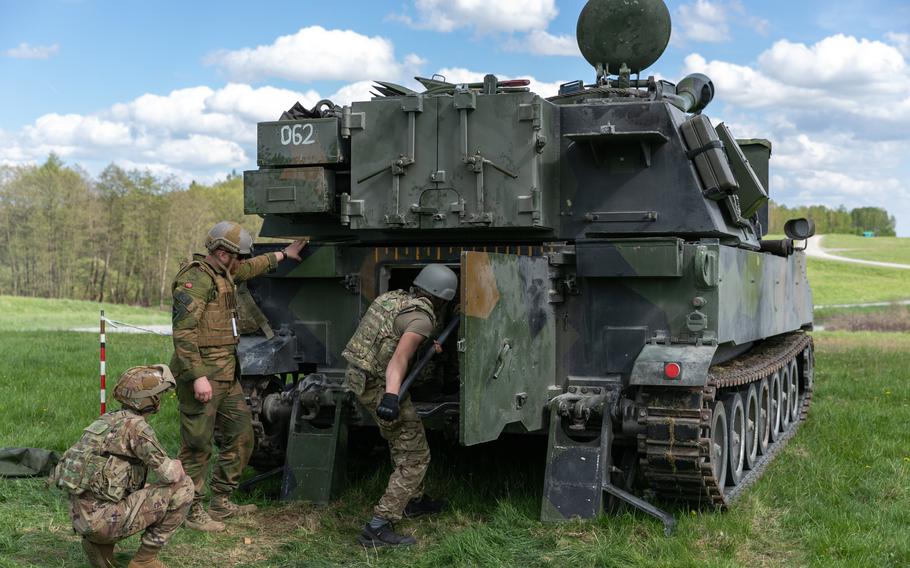
Ukrainian artillerymen load an M109 self-propelled howitzer, during training at Grafenwoehr Training Area, May 12, 2022. Soldiers from the U.S. and Norway trained armed forces of Ukraine artillerymen on the howitzers as part of security assistance packages from their respective countries. (Spencer Rhodes/U.S. Army)
Defense Secretary Lloyd Austin and other top Pentagon officials are weighing a major expansion in training for the Ukrainian military, a move that could significantly enhance its ability to evict Russian forces from occupied areas even as it deepens U.S. involvement in the war.
The plan, under discussion for weeks, according to senior U.S. defense officials, would build on the billions of dollars in weaponry and other aid Washington has provided Ukraine by showing its military how to wage a more sophisticated campaign against the struggling Russian army.
It would see Ukrainian combat units with hundreds, or possibly even thousands of troops, training together in Grafenwoehr, Germany, where the U.S. military has instructed Ukrainian forces in smaller numbers for years. Austin is keen to boost Ukraine’s ability to maneuver on the battlefield with a more modern style of warfare that relies less on launching thousands of rounds of artillery per day at Russian troops in what has become a grinding, bloody war of attrition.
Austin is known to favor the significantly expanded U.S. training program, along with similar programs for tens of thousands of Ukrainian soldiers to be undertaken by Britain, European Union countries and others such as Norway. Germany alone plans to train 5,000 troops by June under the E.U. initiative, at German military combat simulation centers and battalion command posts.
Since the beginning of the war, President Biden has said that the United States and NATO are not at war with Russia, but have a responsibility to assist a fellow democracy in defending itself against unprovoked aggression. Moscow has dismissed those statements, accusing the United States and its allies of using Ukraine as a disposable proxy for their own aims against Russia.
Russia already has escalated its rhetoric in response to the European training announcements. “Don’t say that the U.S. and NATO are not participants in this war,” Foreign Minister Sergei Lavrov told reporters Thursday. “You are directly participating, including not only with the supply of weapons, but also with the training of personnel. . . . You are training their military on your territory, on the territories of Britain, Germany, Italy and other countries.”
The new training, which Ukraine has requested, comes as the war’s tempo is expected to slow, albeit not stop, through Ukraine’s icy winter months and the allies consider how to best take advantage of the time. Counteroffensives south of Kherson, a strategic city on the Black Sea that Russian troops abandoned last month, and into separatist strongholds in the east are expected to be difficult, as the Russians use the time to strengthen their defensive lines.
Ukraine has been able to hand Russian forces battlefield losses in numerous locations, but with significant casualties on both sides. Gen. Mark A. Milley, chairman of the Joint Chiefs of Staff, assessed last month that more than 100,000 Russian soldiers have been killed or wounded since Russia’s invasion Feb. 24, and “probably” an equivalent number of Ukrainian troops.
The Russians are expected to continue to outgun the Ukrainian military, launching tens of thousands of rounds of artillery each day in addition to salvos of missiles and other munitions, according to Western intelligence assessments. At the same time, Russian forces have been increased with the “mobilization” of thousands of additional troops whose effectiveness has so far been limited because of minimal training, low morale and logistics difficulties.
Even as training for Ukrainian forces on specific weapons systems will continue, the Western supply is not infinite. The goal of the new training is to teach the Ukrainians tactics that will enhance the effectiveness of armaments they have, and to use on a larger scale the nimbleness and adaptability they have displayed with small units.
Many of the Ukrainian trainees are expected to be recruits, according to U.S. and European officials, as the Kyiv government continues to mobilize virtually every available resource.
It was not clear whether the expansion of U.S. training would add significantly to the growing cost of aid to Ukraine, already under challenge from some lawmakers, primarily Republicans. While assistance to Ukraine still enjoys widespread bipartisan support, GOP lawmakers who will take over the House next month have vowed increased oversight.
Austin’s vision would in some ways resemble training that U.S. military units receive at their major training hubs, such as the Army’s National Training Center at Fort Irwin in California, and the Marine Corps Air Ground Combat Center in Twentynine Palms, Calif. Before deploying, units spend weeks certifying that they are prepared to fight in combined-arms warfare, where infantrymen, mechanized forces, artillery units and other troops coordinate to find, envelope and destroy enemy units. Discussion of expanded U.S. training for Ukrainian forces was reported earlier by CNN.
The U.S. military’s training of Ukrainian forces began on a large scale after Russia’s 2014 invasion and seizure of Crimea. But much of that instruction concentrated on special operations and resistance rather than full-scale offensives against a dug-in and powerful enemy. Since the invasion last winter, trainers have concentrated on teaching small numbers of soldiers at a time how to perform specific tasks, such as launching and maintaining the howitzer artillery they have been supplied.
A Pentagon spokesman, Air Force Brig. Gen. Patrick Ryder, said Thursday that the Defense Department, alongside Western allies and partner nations, “is constantly exploring ways to support Ukraine through a variety of security assistance efforts, to include training.” The department, he added, had no new announcements to make.
The Washington Post’s Loveday Morris in Berlin contributed to this report.